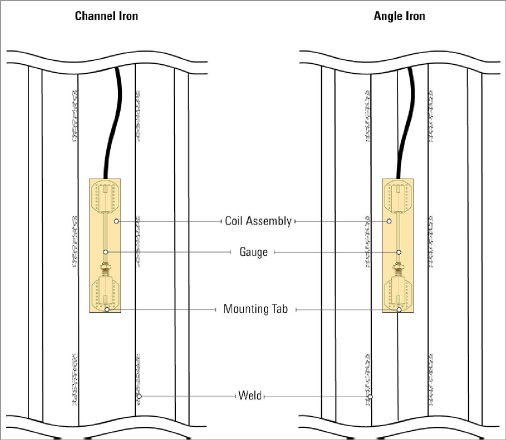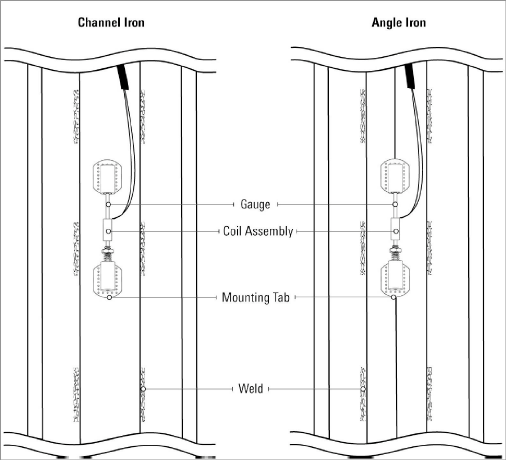3.Instrument Protection
3.1Cable Splicing and Termination
Terminal boxes with sealed cable entries are available from geokon for all types of applications. These allow many instruments to be terminated at one location with complete protection of the lead wires. The interior panel of the terminal box can have built-in jacks or a single connection with a rotary position selector switch. Contact geokon for specific application information.
Because the vibrating wire output signal is a frequency rather than a current or voltage, variations in cable resistance have little effect on instrument readings; therefore, splicing of cables has no ill effects, and in some cases may in fact be beneficial. The cable used for making splices should be a high quality twisted pair type, with 100% shielding and an integral shield drain wire. When splicing, it is very important that the shield drain wires be spliced together. Always maintain polarity by connecting color to color.
Splice kits recommended by geokon incorporate casts that are placed around the splice and are then filled with epoxy to waterproof the connections. When properly made, this type of splice is equal or superior to the cable in strength and electrical properties. Contact geokon for splicing materials and additional cable splicing instructions.
Terminate a cable by stripping and tinning the individual conductors and then connecting them to the patch cord of a readout box. Alternatively, use a connector to plug directly into the readout box or to a receptacle on a special patch cord.
3.2Protection from Mechanical Damage
The cover of the 4100 coil housing provides a measure of protection for the strain gauge, which is adequate in most cases. In extreme environments and/or where long term performance is required, gauge and lead wires may require additional protection from corrosion and mechanical damage.
Cables should be adequately restrained so that there is no danger of the coil housing being damaged (Model 4100) or the lead wires torn out (Model 4150) by tugging on the cable. Cables may be secured using pieces of stainless steel shim strips (supplied), spot welded in place over the top of the cable. Tie wraps, tape, or wire ties may also be used to secure the gauge cables.
Gauges can be further protected by welding cover plates composed of 101 x 38 mm (4" x 1.5") channel iron or 64 mm (2.5") or larger angle iron over the top of the gauges.
To avoid damaging the cables, the protection should be welded on before the gauges and cables are installed. To accomplish this, leave windows in the steel over the gauge locations.
Note: It is not necessary to use continuous welds; tack welding is sufficient as long as it holds the angles or channels firmly in place. Cables must be restrained using welding studs, to which the cables can be tied at three-meter intervals.
4:

Figure 4: Model 4100 Cover Plate - Top View
5:

Figure 5: Model 4150 Cover Plate - Top View
6:

Figure 6: Cover Plate - End View
INSTALL THE COVER PLATES AS FOLLOWS:
1.Weld the two 9.5 x 51 mm (3/8 x 2") long hex bolts in place head down. The bolts should be spaced at a nominal 530 mm (21") apart. A spacer jig is available from geokon, or the cover plate can be flipped onto its back and the holes in the cover plate can be used to mark the bolt locations. One hole in the cover plate is slotted, so the spacing is not critical. Avoid welding anywhere near the gauge as this will cause large local distortions in the metal. Use either a special stud welder or an arc welder to weld the head of the bolt to the surface.
2.Place the cover plate over the welded bolts.
3.Install washers, then nuts. Avoid excessive force while tightening the cover retaining nuts, as this will distort the underlying steel surface and can give rise to spurious strain readings.
7:

Figure 7: Cover Plate Installation, Top View
8:

Figure 8: Cover Plate Installation, Side View
3.3Cable and Connector Protection
The cable should be protected from accidental damage caused by moving equipment or fly rock. This is best accomplished by putting the cable inside flexible conduit and positioning the conduit in as safe a place as possible. (Flexible conduit is available from geokon.) The conduit can be connected via conduit bulkhead connectors to the cover plates. (The geokon cover plate has a stamped knockout which, when removed, provides a hole for connecting the conduit connector.)
It is imperative that installation weld points, if any, be protected from corrosion. Stainless steel instruments will not corrode, but the substrate can corrode, especially at weld points, unless they are covered by a waterproofing layer. geokon recommends you follow this procedure:
1.Apply several drops of cyanoacrylate adhesive to the edge of all spot welded mounting tabs. The glue will wick into the gap between the mounting tabs and the substrate and provide the first line of defense.
2.Mask off the areas where spot welds are needed.
3.Spray self-etching primer (available locally) over mounting tab areas and all exposed bare metal areas. The idea is to protect substrate weld points. It is important to completely cover mounting tab edges, paying attention to where the tab is under the instrument. Be sure to spray beneath the coil housing, if applicable; do not worry if the primer also coats the instrument.
4.Apply a coat of paint over the primed areas.
In severe environments and for long term protection, the space between the coil housing and the Model 4100 gauge, and the space between the cover plate and the Model 4150 gauge, can be filled with a stiff grease (e.g., axle grease). For further protection, the entire assembly can be covered by a layer of insulating mastic (e.g. Plymouth 10 Plyseal), which is available from geokon.
3.5Protection From Electrical Noise
Be sure to install instrument cables as far away as possible from sources of electrical interference such as power lines, generators, motors, transformers, arc welders, etc. Cables should never be buried or run with AC power lines. Doing so will cause the instrument cables to pick up the frequency noise from the power cable, and this will likely make obtaining a stable reading difficult.
3.6Protection From Sunlight and Temperature Changes
If attached to a steel structure, the thermal coefficient of expansion of the steel vibrating wire inside the instrument is the same as that for the structure. This means that no temperature correction for the measured strain is required when calculating load-induced strains. However, this is only true if the wire and the underlying steel structure are at the same temperature. If sunlight is allowed to impinge directly onto the gauge, it could elevate the temperature of the wire above the surrounding steel and cause large changes in apparent strain. Therefore, always shield strain gauges from direct sunlight. Protection from thermal effects is best provided by covering the gauges with a layer of insulating material such as Polystyrene foam or fiberglass.
Unlike numerous other types of instrumentation available from geokon, vibrating wire strain instruments do not have any integral lightning protection components, such as transorbs or plasma surge arrestors.
Suggested Lightning Protection Options:
■Lighting arrestor boards and enclosures are available from geokon. These units install where the instrument cable exits the structure being monitored. The enclosure has a removable top to allow the customer to service the components or replace the board in the event that the unit is damaged by a lightning strike. A connection is made between the enclosure and earth ground to facilitate the passing of transients away from the instruments. See the figure below.
■Plasma surge arrestors can be epoxied into the instrument cable, close to the instrument. A ground strap then connects the surge arrestor to an earth ground, such as a grounding stake or the steel structure.
Consult the factory for additional information on available lightning protection.
9:

Figure 9: Lightning Protection Scheme